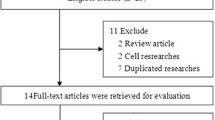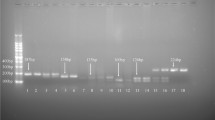Abstract
We examined the distribution of the CCND1 A870G (rs9344) polymorphic variant in patients with cervical cancer (n = 129) and healthy individuals (n = 288) in a sample of a Polish cohort. We showed that patients with advanced cervical cancer bearing the CCND1 A/A and A/G genotypes displayed a 1.811-fold increased risk of cervical cancer (95% CI = 1.150–2.852, p = 0.0098). We also found a significantly higher frequency of the CCND1 870A allele in patients with cancer than in controls, p = 0.0116. Our investigation confirmed that the CCND1 870A gene variant may be a genetic risk factor in the incidence of advanced cervical cancer.
Similar content being viewed by others
References
Parkin DM, Bray F, Ferlay J, Pisani P et al (2005) Global cancer statistics, 2002. CA Cancer J Clin 55:74–108
Parkin DM, Bray F (2006) Chapter 2: the burden of HPV-related cancers. Vaccine 24(S3):11–25
Muñoz N, Bosch FX, de Sanjosé S et al (2003) Epidemiologic classification of human papillomavirus types associated with cervical cancer. N Engl J Med 348:518–527
Baseman JG, Koutsky LA (2005) The epidemiology of human papillomavirus infections. J Clin Virol 32(Suppl 1):S16–24
Magnusson PK, Sparen P, Gyllensten UB (1999) Genetic link to cervical tumours. Nature 400:29–30
Hemminki K, Dong C, Vaittinen P (1999) Familial risks in cervical cancer: is there a hereditary component? Int J Cancer 82:775–781
Hemminki K, Chen B (2006) Familial risks for cervical tumors in full and half siblings: etiologic apportioning. Cancer Epidemiol BiomarkersPrev 15:1413–1414
Kim JK, Diehl JA (2009) Nuclear cyclin D1: an oncogenic driver in human cancer. J Cell Physiol 220:292–296
Hall M, Peters G (1996) Genetic alterations of cyclins, cyclin-dependent kinases, and Cdk inhibitors in human cancer. Adv Cancer Res 68:67–108
Wang L, Habuchi T, Mitsumori K et al (2003) Increased risk of prostate cancer associated with AA genotype of cyclin D1 gene A870G polymorphism. Int J Cancer 103:116–120
Onay UV, Aaltonen K, Briollais L et al (2008) Combined effect of CCND1 and COMT polymorphisms and increased breast cancer risk. BMC Cancer 8:6
Le Marchand L, Seifried A, Lum-Jones A et al (2003) Association of the cyclin D1 A870G polymorphism with advanced colorectal cancer. JAMA 290:2843–2848
Rydzanicz M, Golusinski P, Mielcarek-Kuchta D et al (2006) Cyclin D1 gene (CCND1) polymorphism and the risk of squamous cell carcinoma of the larynx. Eur Arch Otorhinolaryngol 263:43–48
Izzo JG, Malhotra U, Wu TT et al (2005) Impact of cyclin D1 A870G polymorphism in esophageal adenocarcinoma tumorigenesis. Semin Oncol 32:S11–5
Hou X, Wang S, Zhou Y et al (2005) Cyclin D1 gene polymorphism and susceptibility to childhood acute lymphoblastic leukemia in a Chinese population. Int J Hematol 82:206–209
Castro FA, Haimila K, Sareneva I et al (2009) Association of HLA-DRB1, interleukin-6 and cyclin D1 polymorphisms with cervical cancer in the Swedish population–a candidate gene approach. Int J Cancer 125:1851–1858
Thakur N, Hussain S, Kohaar I et al (2009) Genetic variant of CCND1: association with HPV-mediated cervical cancer in Indian population. Biomarkers 14:219–225
Satinder K, Chander SR, Pushpinder K et al (2008) Cyclin D1 (G870A) polymorphism and risk of cervix cancer: a case control study in north Indian population. Mol Cell Biochem 315:151–157
Betticher DC, Thatcher N, Altermatt HJ et al (1995) Alternate splicing produces a novel cyclin D1 transcript. Oncogene 11:1005–11011
Lu F, Gladden AB, Diehl JA (2003) An alternatively spliced cyclin D1 isoform, cyclin D1b, is a nuclear oncogene. Cancer Res 63:7056–7061
Solomon DA, Wang Y, Fox SR et al (2003) Cyclin D1 splice variants. Differential effects on localization, RB phosphorylation, and cellular transformation. J Biol Chem 278:30339–30347
Jeon YT, Kim JW, Song JH et al (2005) Cyclin D1 G870A polymorphism and squamous cell carcinoma of the uterine cervix in Korean women. Cancer Lett 223:259–263
Catarino R, Matos A, Pinto D et al (2005) Increased risk of cervical cancer associated with cyclin D1 gene A870G polymorphism. Cancer Genet Cytogenet 160:49–54
Martin CM, Astbury K, O'Leary JJ (2006) Molecular profiling of cervical neoplasia. Expert Rev Mol Diagn 6:217–229
Sherr CJ (1993) Mammalian G1 cyclins. Cell 73:1059–1065
Sherr CJ, Roberts JM (1999) CDK inhibitors: positive and negative regulators of G1-phase progression. Genes Dev 13:1501–1512
Jares P, Colomer D, Campo E (2007) Genetic and molecular pathogenesis of mantle cell lymphoma: perspectives for new targeted therapeutics. Nat Rev Cancer 7:750–762
Jin M, Inoue S, Umemura T et al (2001) Cyclin D1, p16 and retinoblastoma gene product expression as a predictor for prognosis in non-small cell lung cancer at stages I and II. Lung Cancer 34:207–218
Bartkova J, Lukas J, Muller H et al (1995) Abnormal patterns of D-type cyclin expression and G1 regulation in human head and neck cancer. Cancer Res 55:949–956
Bartkova J, Lukas J, Muller H et al (1994) Cyclin D1 protein expression and function in human breast cancer. Int J Cancer 57:353–361
Shamma A, Doki Y, Shiozaki H et al (2000) Cyclin D1 overexpression in esophageal dysplasia: a possible biomarker for carcinogenesis of esophageal squamous cell carcinoma. Int J Oncol 16:261–266
Al Moustafa AE, Foulkes WD, Wong A et al (2004) Cyclin D1 is essential for neoplastic transformation induced by both E6/E7 and E6/E7/ErbB-2 cooperation in normal cells. Oncogene 23:5252–5256
Wang L, Habuchi T, Takahashi T et al (2002) Carcinogenesis 23:257–264
Pabalan N, Bapat B, Sung L et al (2008) Cyclin D1 Pro241Pro (CCND1-G870A) polymorphism is associated with increased cancer risk in human populations: a meta-analysis. Cancer Epidemiol Biomarkers Prev 17:2773–2781
Huh K, Zhou X, Hayakawa H et al (2007) Human papillomavirus type 16 E7 oncoprotein associates with the cullin 2 ubiquitin ligase complex, which contributes to degradation of the retinoblastoma tumor suppressor. J Virol 81:9737–9747
Huh KW, DeMasi J, Ogawa H et al (2005) Association of the human papillomavirus type 16 E7 oncoprotein with the 600-kDa retinoblastoma protein-associated factor, p600. Proc Natl Acad Sci U S A 102:11492–11497
Acknowledgements
Supported by grant No 502-01-01124182-07474, Poznań University of Medical Sciences.
Author information
Authors and Affiliations
Corresponding author
Rights and permissions
About this article
Cite this article
Warchoł, T., Kruszyna, Ł., Lianeri, M. et al. Distribution of CCND1 A870G Polymorphism in Patients with Advanced Uterine Cervical Carcinoma. Pathol. Oncol. Res. 17, 133–137 (2011). https://doi.org/10.1007/s12253-010-9293-3
Received:
Accepted:
Published:
Issue Date:
DOI: https://doi.org/10.1007/s12253-010-9293-3




